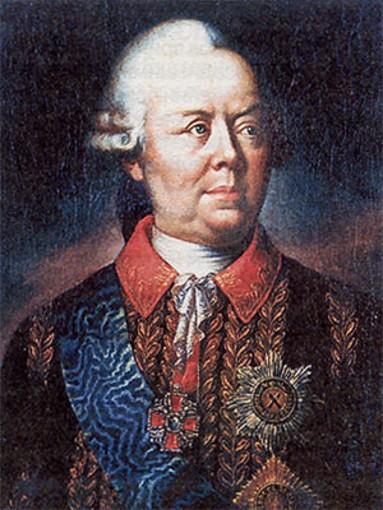Rumiantsev, Petr
Rumiantsev, Petr [Rumjantsev], b 15 January 1725 in Moscow, d 19 December 1796 in Taman, Pereiaslav county, Kyiv vicegerency. (Portrait: Petr Rumiantsev.) Russian military leader and statesman. He first distinguished himself as a general in the Seven Years' War. In November 1764, after Kyrylo Rozumovsky was forced to resign as hetman of the Left-Bank Hetman state, Empress Catherine II appointed Rumiantsev president of the Little Russian Collegium (1764–86) and governor-general (1764–89) of Little Russia (ie, Left-Bank Ukraine). He also commanded the Russian army that invaded Moldavia and Wallachia during the 1769–74 Russo-Turkish War and the ‘Ukrainian’ army that fought in the 1787–91 war. He personally negotiated the 1774 Peace Treaty of Küçük Kaynarca.
As Catherine II's viceroy in Left-Bank Ukraine Rumiantsev implemented the centralist policies of the Russian government and eradicated the vestiges of Ukrainian autonomy, entrenching the Russian administrative and court systems. He instituted the Rumiantsev census of Little Russia (1765–9). During the elections to the 1767 Legislative Commission he repressed Cossack starshyna and clergy who voiced Ukrainian autonomist demands. He initiated a series of reforms of the Hetmanate's military, tax system, and schools and in 1765 introduced a postal service. The Hetmanate's regimental system was abolished in 1781–2; Little Russia was divided among three vicegerencies (Kyiv vicegerency, Chernihiv vicegerency, and Novhorod-Siverskyi vicegerency) in 1782; and the poll tax was introduced and the Cossack army transformed into Russian carabineer regiments in 1783. Rumiantsev supervised the imposition of serfdom on the Ukrainian peasantry after Catherine's decree of May 1783, the implementation of Catherine's May 1785 charters to the nobility and the towns defining their rights and obligations, and the secularization of monastic properties in 1786.
In the 1780s Rumiantsev allied himself with noble circles (including Ukrainian autonomists) that supported the future tsar, Paul I, and were opposed to Catherine II's favorite, Grigorii Potemkin. Rumiantsev thus incurred the wrath of Catherine, who had him removed as governor-general in 1789 and replaced with Mikhail Krechetnikov in 1790. Rumiantsev amassed huge estates in Ukraine. He spent his final years there and was buried in the Kyivan Cave Monastery in 1797. His descendants owned the estates until the Revolution of 1917.
BIBLIOGRAPHY
Maksimovich, G. Deiatel’nost’ Rumiantseva-Zadunaiskago po upravleniiu Malorossiei (Nizhen 1913)
Korobkov, N. Fel’dmarshal Rumiantsev-Zadunaiskii (Moscow 1944)
———. (ed). Fel’dmarshal Rumiantsev (1725–1796): Sbornik dokumentov (Moscow 1947)
Fortunatov, P. (ed). P.A. Rumiantsev: Dokumenty, 2 vols (Moscow 1953)
Ohloblyn, O. ‘Ukrainian Autonomists of the 1780's and 1790's and Count P.A. Rumyantsev-Zadunaysky,’ AUA, 6, no. 3–4 (1958)
P.A. Rumiantsev, A.V. Suvorov, M.I. Kutuzov: Dokumenty i materialy (Kyiv 1974)
Kohut, Z. Russian Centralism and Ukrainian Autonomy: Imperial Absorption of the Hetmanate, 1760s–1830s (Cambridge, Mass 1988)
Oleksander Ohloblyn
[This article originally appeared in the Encyclopedia of Ukraine, vol. 4 (1993).]

.jpg)